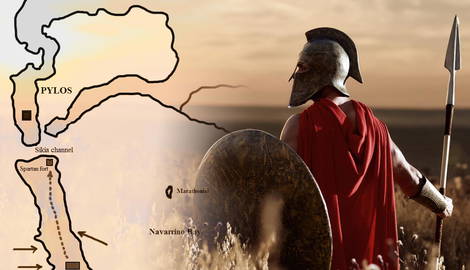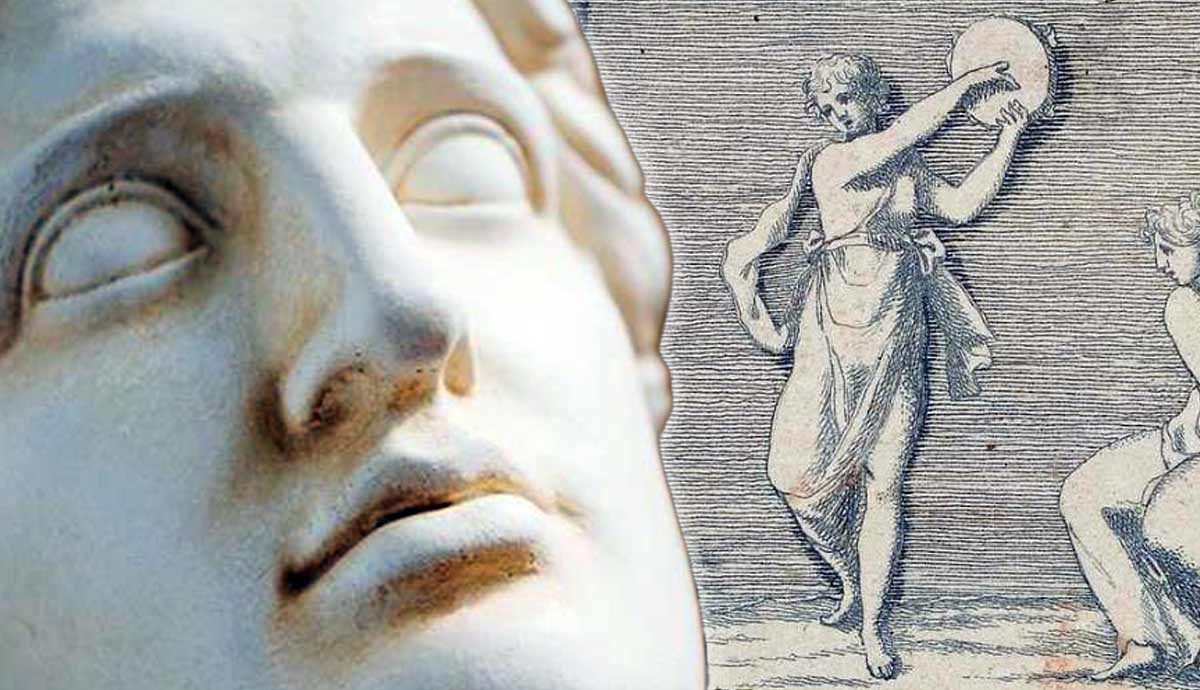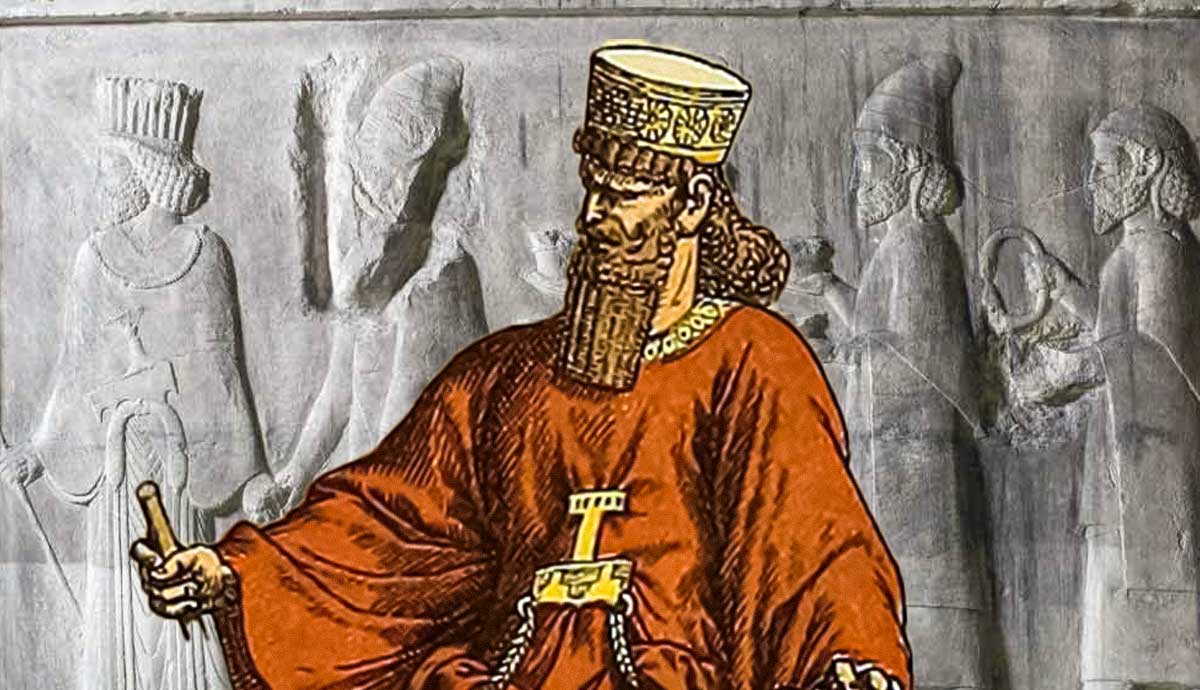
In 425 BCE, during the early phase of the Peloponnesian War, known as the Archidamian War (431-421 BCE), the Athenians under Demosthenes captured the Island of Pylos. The Athenian capture of Pylos posed a significant threat to Sparta by providing a prime raiding base near Spartan territory. A failed attempt by the Spartans to recapture Pylos resulted in the defeat of its navy and a contingent of Spartans trapped on the island of Sphacteria. This set the scene for the Battle of Sphacteria.
War of Words

In 425 BCE, Sparta found itself in a desperate situation. It had just suffered a defeat close to home and the contingent trapped on Sphacteria was no small matter. To put this in context, of the 440 soldiers trapped on the island, 120 were Spartan full-citizen hoplites (Spartiates) and made up approximately a tenth of Sparta’s elite class of warriors. Sparta was desperate to get these men back and immediately sent an embassy to negotiate a truce.
The victory at Pylos put Athens in a position to negotiate for a favorable peace. Thucydides states that the Spartan ambassadors who addressed the Athenian assembly offered peace and an alliance between Sparta and Athens:
“The Spartans accordingly invite you to make a treaty and to end the war, and offer peace and alliance and the most friendly and intimate relations in every way and on every occasion between us; and in return ask for the men on the island” (Thuc. 4.19.1).
The offer was seriously considered as many wanted an end to the war, especially the aristocratic party of Nicias who opposed the aggressive imperialism of the democrats. However, Cleon, a warmongering demagogue and skilled orator who headed Athens’ democratic party, swayed the people in the assembly to demand more severe terms. These included Athens gaining control over Megara and the insistence that Sparta abandon several key allies. Attempts by the Spartan embassy to negotiate in private failed. Cleon rejected the request for talks behind closed doors and demanded they negotiate publicly. Sparta’s hand was forced as it could not discuss the betrayal of her allies in the open and negotiations broke down.
The Island of Sphacteria

Command of the Sphacteria campaign was given to Cleon, who boldly claimed that he did not fear the Spartans and would sail for the island without taking any Athenian citizens to go fight. He took with him contingents from Lemnos and Imbros, and several light troops consisting of peltasts and archers. Upon arrival, he combined his forces with those who were blockading the island. The actual strategist of the campaign was, however, the experienced officer Demosthenes.
The island was extremely wooded, making it difficult to track the Spartan movements. Thus, the Athenians were wary of landing their forces, fearing an ambush. As fortune had it, a wildfire broke out on the island, revealing the Spartan positions as well as the best landing spots.
The Spartans occupied three positions on the island. The main force was stationed close to the center around a fountain that served as their water supply. The second division occupied the remains of an abandoned fort on the highest point of the island. The final and smallest contingent was stationed in the south of the island, acting as sentries to guard against possible landing points in the area.
The Night Attack

The Athenians had 800 hoplites, 800 peltasts, and 800 archers, supported by an unknown number of additional psiloi (light infantry) drawn from the crews of the ships. They vastly outnumbered their Spartan foes. The renowned Spartan martial reputation, however, was so feared that Demosthenes’ strategy was to avoid a heavy infantry engagement at all costs, despite their numerical superiority. An embassy was sent to offer terms of surrender to the Spartans, but unsurprisingly and in true Spartan fashion, the offer was rejected.
The following night, under the cover of darkness, the Athenians landed a vanguard on the southern points of the island. With a daring night attack, they overran the small contingent, who were completely caught off guard with many of the Spartans killed in their beds:
“The Athenians rushed the first guards and killed them instantly – they were still in bed or grabbing for their weapons. The landing had gone unnoticed, as the guards had thought that the ships were simply moving to their usual nightly anchorage” (Thuc. 4.32.1).
When morning arrived, the rest of the Athenian army disembarked on the island. They quickly surrounded the main Spartan force by occupying the high ground around the Spartan camp. The Spartan hoplites, never shying away from battle, formed up and marched out to meet the enemy, confident in the martial prowess and the defense of their tightly formed phalanx.
Deadly Tactics of Demosthenes

The Athenian heavy infantry hoplites, embracing Demosthenes’ strategy, refused to engage their Spartan counterparts. The Athenian light troops consisting of javelinmen, archers, and slingers, rushed in and outflanked the Spartans on all sides. What followed was a hailstorm of arrows, stones, and javelins:
“[The Spartans] formed for battle and advanced towards the Athenian hoplites, wanting to come to close quarters: the hoplites were positioned directly in front of them, with the light-armed troops on the flanks and behind them. The Spartans could not get at the hoplites or make use of their own expertise, as they were kept back by a barrage of missiles from the light-armed troops on either side, and also the hoplites would not advance to meet them but stayed where they were” (Thuc. 4.33.1).

The Spartans attempted to respond to the threat by rushing out from their formation, trying to close with their enemies. Clad in their armor and carrying their heavy aspis shields, they were slow while their attackers were swift due to their light gear and lack of armor. To make matters worse, every time the Spartan warriors broke rank and tried to attack the light troops, they found themselves exposed and vulnerable to the enemy’s missiles:
“Being lightly equipped they could easily outpace any pursuit in this difficult terrain, left rough by lack of habitation, and the Spartans in their heavy armor could not chase them over such ground” (Thuc. 4.33.2).
To put it simply, the Spartans had no means to answer the ranged attacks of their enemy. Casualties were mounting among the Spartans, and the once invulnerable image of the Spartan war machine was being chipped away by every warrior that fell. Their fruitless sallies to catch the enemy light troops and the weight of the armor only served to exhaust them.
Sparta’s Last Stand

Realizing the hopelessness of the situation, the Spartans tightened their ranks, and under the continuous barrage of missiles, they decided to retreat to the abandoned fort where the other contingent of Spartans were entrenched. A slow and grueling retreat ensued, and more Spartans fell before they reached the fort, which finally awarded some respite among fresh troops. More importantly, the remains of the fort and the natural high ground of the place afforded them some defense against the missiles of their pursuers. What ensued was a stalemate. The Spartans had no means to drive off the assailants, while the light troops of the Athenians, who were starting to run low on ammunition, could not dislodge the Spartans from the high ground.
In the hopes of breaking the stalemate, the captain of the Messenians realized that if they could scale the cliffs behind the fort, the Spartans could be outflanked and attacked in the rear. He thus requested a contingent of archers along with other light troops from Demosthenes, and, in a daring attempt, he circumnavigated the Spartan position and surmounted the cliffs. The sudden appearance of the light troops behind the Spartans caused fear and panic among them while it invigorated the Athenians.
“The Spartans were now under attack from front and rear… so these Spartans could not hold out any longer, caught as they were between two fires. They were few fighting many and weakened by lack of food, and they began to give way with the Athenians controlling every approach to their position” (Thuc. 4.36.3).

The Spartans were now in a dire situation. Had it not been for Cleon and Demosthenes calling a halt to the relentless attack, the Spartans would have all been massacred. Amongst the dead lay Epitadas, the Spartan commander. The second officer, Hippagretus, was severely wounded, a testament to the carnage and effectiveness of light troops. It was thus the third officer, Styphon, who had to accept the armistice offered by Cleon. The remaining Spartans were exhausted, without supplies, surrounded, and outnumbered. They were left with little choice between surrender or death. The Spartans chose to surrender.
How Sphacteria Changed Greece

When the unbreakable Spartans broke and surrendered, it sent shockwaves through the Greek world:
“To the Greeks, this was the most surprising event of the whole war. They had thought that Spartans would never surrender their arms, in starvation or any other extremity, but would use them to the last of their strength and die fighting” (Thuc. 4.40.1).
More importantly, the battle was won with light infantry. Sparta’s invincibility was destroyed by the most unlikely soldiers. These slingers, archers, and javelin men were seen as inferior troops and second-class citizens, yet they defeated the greatest warriors in Greece. More than a quarter of the Spartan forces perished in the battle, while the Athenians lost very few men because the battle was not fought at close quarters.
The battle also changed the nature of the war. No longer could Greek armies dominate a battlefield by fielding only heavy infantry. Combined arms became essential in Greek warfare. Even Sparta, the most conservative of the Greeks, realized the importance of fielding combined arms: “Contrary to their usual custom they raised a force of four hundred cavalry and archers” (Thuc. 4.55.2).
Sphacteria also changed the war on a larger scale. Sparta could no longer invade Attica and raid their lands, as any military action in Attica would result in the execution of the Spartan prisoners taken on the island. Spartan lands, however, were under constant threat from the newly created Athenian base on Pylos, which was managed by their Messenian allies. According to Thucydides (5.75.3), Sparta would only regain their reputation seven years later after defeating their enemies at the climactic Battle of Mantinea in 418 BCE, turning the tide of the war in favor of Sparta.










